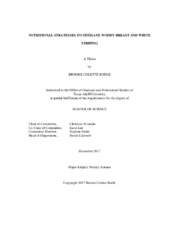| dc.description.abstract | The aim of this research program was to evaluate the effect of multiple nutritional strategies on broiler performance, meat yield, and the presence and severity of white striping and woody breast in high-yielding, male broilers.
Nutritional strategies explored in Experiment I included an increased level of dArg:dLys, inclusion of vitamin C, doubling the recommended vitamin premix inclusion, or reducing amino acid density 15% during the grower phase. The reduction in amino acid density during Experiment I suppressed body weight and increased feed conversion ratio during the grower and finisher phases. No differences were observed in average breast weight; however, breast yield (as a % of live weight) was significantly reduced in diets containing vitamin C, while all other diets showed similar results to that of the control. Diets containing a higher dArg:dLys, higher vitamin C, and a lower amino acid density significantly reduced the severity of woody breast compared to the industry standard diet. However, no differences in incidence of white striping were observed.
Supplementation of 136 dArg:dLys and 100 ppm vitamin C in Experiment II significantly improved feed consumption and feed conversion ratio. At the termination of the trial, the inclusion of 136 dArg:dLys significantly improved feed conversion ratio compared to the control. No differences in breast weight were observed, however, the diets containing 124 dArg: dLys significantly reduced breast yield compared to the control. Similarly, the diets containing 124 dArg:dLys significantly reduced the severity of woody breast and white striping compared to the control diet. Furthermore, the control significantly increased the number of severe woody breast scores, compared to diets containing 124 dArg:dLys by 11% and 14.30%, respectively. Similarly, the diets containing 124 dArg:dLys significantly improved the normal and mild white striping scores compared to the positive control by 20.72% and 18.92%, respectively. The inclusion of arginine and vitamin C reduced the severity and incidence of woody breast and white striping compared to an industry standard diet. | en |


